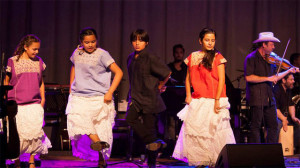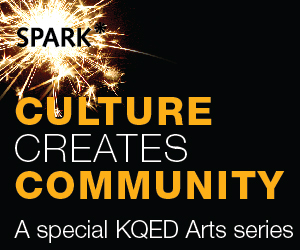“We’re a factory of culture,” Rodriguez says. A factory with a lot of outside support. Students in this working class neighborhood pay about a third of the cost of the piano, dance, violin, conga, and other lessons offered, with fundraisers and help from foundations making up the difference.
Rodriguez founded Los Cenzontles in 1989. He had a Masters in classical guitar from the San Francisco Conservatory of Music, but “the thought of playing solo guitar was a lonely thought for me.” So Rodriguez took a grant from the California Arts Council and began teaching Mexican folk music and dance to a group of East Bay kids. He says he grew up in Los Angeles, in a second generation Mexican American family. “It was a very warm, connecting thing to be part of music when I was growing up… and so I wanted to extend that to other people’s children who didn’t have that in their homes.”
Rodriguez’s organization has grown into a school that teaches 200 students a week. But it still feels like family — with son Emiliano running the studio, and wife Marie-Astrid teaching arts and crafts. And the family keeps growing.
Lucina Rodriguez came to Los Cenzontles 19 years ago to study dance. Now she teaches it, writes songs, and sings in the band. She specializes in zapateados, a kind of Mexican tap-dance. Some she learned in Veracruz on one of Cenzontles’ many musical expeditions, well before Son Jarocho music from this region on the Pacific gained the renewal of popularity it now enjoys.
Lucina recalls, in musical terms, how isolated she felt as a young Mexican immigrant arriving in San Pablo, even from Mexican Americans who’d lived here for generations. “The Chicanos would listen to hip-hop and rap,” she says, “and we would listen to Banda and Norteño. It was like a huge difference.” But she says the two groups found common ground at Los Cenzontles.
“The Traditional Mexican music is what brought us together. And that’s what Los Cenzontles does. It gives a place for everyone to be, for everyone to feel comfortable. So that sort of tension was really just at the beginning, and then, it’s like ‘Oh we’re all the same.'”
About three in the afternoon, parents begin dropping off their kids for arts and crafts, dance and music lessons. Some older students, including Emily Reachi take over the stage, rehearsing a song for the upcoming Christmas show.
Reachi is also part of the Los Cenzontles touring band. She dances and plays the percussion instrument called the quijada, the mule jaw. “You use an antler of a deer, and then you scrape the teeth and hit it with your palm, on the side so you can make the teeth rattle.”
Reachi is a poster child for the way Los Cenzontles knits generations together. She shares all the songs she learns with her grandmother. “And she says, ‘I know that, too.'” Reachi says, “And she gives me the whole history about it. So she helps me out, because I want to learn about the music.”
But her grandmother wouldn’t recognize some of Los Cenzontles’ blues and rock inflected songs. “We’re kind of connecting cultures,” says Eugene Rodriguez, who even as he values tradition, likes to mess with it. “So we’ll take a Mexican Ranchera which is bone-chunk-chunk, bone-chunk-chunk and you got rock and roll which has this boom-chack-boom, this backbeat, and then we stick them together.” Rodriguez’s “Invisible Man,” for instance, is one of many new songs and videos on the Los Cenzontles YouTube channel.
“It’s got this heavy blues cumbia,” Rodriguez says, “which is a Latin rhythm. It’s in English. I think it’s an effective song. And to me, it’s rock and roll, and it’s blues, but it’s Mexican, and it reflects our feeling in the deepest way. I still think it’s folk music, as I see it.”
Rodriguez worked on the song with a frequent collaborator, David Hidalgo, of Los Lobos. You can also hear roots music greats like Taj Mahal, Ry Cooder, and Pete Sears on their recordings, and Linda Ronstadt has lent her voice and support to Los Cenzontles for almost 20 years.
“They’re teaching children how to process their feelings, how to deal with what their lives are by using art.” Ronstadt says. “They don’t have to grow up to be performers, they can grow up to be bankers, or nurses, or doctors, or whatever they want to do. But they’ll always know what the etiquette is to jump on top of the Tarima [a box to amplify the steps of a zapateado] and dance and express their sorrow in some kind of musical or visually artistic way.”
Los Cenzontles has been raising funds recently to improve the facilities at the center. They’ve expanded into what was a neighboring laundromat, added a kitchen for cooking classes, and they want to expand and modernize their recording studio. During a recent interview, Eugene Rodriguez talked about the organization and its future, in between getting a worker to fix a leak in the new roof. “Some people see tradition like handcuffs,” he says, but he sees it as a tool to help kids manage their lives.
“What we’re trying to tell the kids is not to tell them to do this or do that, but to get them engaged in the conversation, their internal conversation so they can make the best choices using the best of all they have from all the worlds inside of them.”




